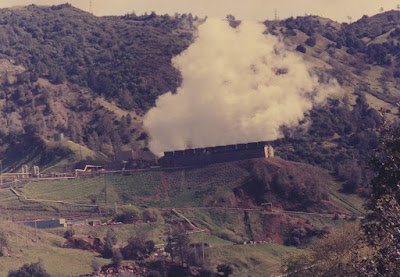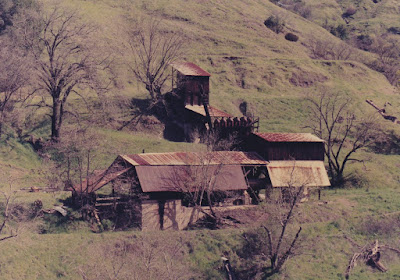 |
| Photo by Cliff West |
On our family's California trip, my dad planned to spend a night in a motel in San Francisco, until he found out how much they cost. He then decided to head north to Santa Rosa, where we stayed in a much nicer and less expensive motel, saying we could always drive back to San Francisco. Yet, when the morning of March 17, 1992, came, we continued north instead, and came across signs for "The Geysers." Not knowing what "The Geysers" were, he decided to follow the signs and find out, hoping to perhaps discover California's version of Yellowstone's Old Faithful. Instead, after following a long and winding road, all we came across was a vista point with the plaque pictured above, declaring The Geysers Geothermal Power Development a California Historic Civil Engineering Landmark by the American Society of Civil Engineers, and we realized that whatever geysers might have been there had long since had geothermal power plants built on top of them. (We actually had seen one small spring along the road, but didn't bother to take a picture as at that point we still had hope there would be bigger ones up the road. There weren't.)
 |
| Photo by Cliff West |
This is an example of what we found instead. Pacific Gas & Electric Units 5 & 6 were started up in December 1971 and have a combined generating capacity of 110 megawatts. After the 1996 deregulation of California's power generation industry, Pacific Gas & Electric sold its geothermal power plants at The Geysers to the Calpine Corporation in 1999. Today, this facility is called the McCabe Power Plant and is still in operation.
 |
| Photo by Cliff West |
Though hardly worth the long drive, the viewpoint did offer some scenic vistas. Here is what appears to be a spring emerging from the hillside to form a small waterfall as it cascades down into Big Sulfur Creek. The Geysers is the world's largest geothermal field, but it never actually contained any geysers. It was named by a white settler named William Bell Elliot who stumbled across the area in 1847. The phenomena in this area are actually fumaroles, which emit only steam. Tourists began coming to the area in 1848, and construction of The Geysers Resort Hotel began in 1854 near the vista point. Though the hotel was destroyed by fire on February 2, 1938, the resort continued operating with cabins until 1980, when it was dismantled.
 |
| Photo by Cliff West |
In the foreground are Pacific Gas & Electric Units 3 & 4, which were started up in 1967 and 1968, respectively. Each had a generating capacity of 28 megawatts. These units were taken offline in 1992 (as this picture was taken in March, I am not sure if they were already offline or not) and were dismantled in 1995.
On top of the hill are Pacific Gas & Electric Units 7 & 8. They were started up in November 1972 and have a combined generation capacity of 110 megawatts. Sold to Calpine Corporation in 1999, this facility is still operating today as the Ridge Line Power Plant.
 |
| Photo by Cliff West |
Here is another view of Pacific Gas & Electric Units 3 & 4 from a point further down the road. In 1920, a gravel pit owner from Healdsburg, California, named John D. Grant took out a lease on The Geysers property with a plan to use the steam to generate electricity. His first well, drilled in 1921, was unsuccessful, but his second well became the first successful geothermal well drilled for electrical power generation outside the Larderello Geothermal Field in Tuscany, Italy. Grant completed the 318 foot deep well in July 1923 and subsequently built a 35-kilowatt power plant, however, startup costs and technical problem combined with cheap oil prices doomed the venture. Some of the General Electric generating equipment was eventually used to power The Geysers Resort Hotel.
 |
| Photo by Cliff West |
In 1955, the Magma Power Company drilled a new modern well at The Geysers, followed by five more in the next two years. In October 1958, Pacific Gas & Electric signed a contract to purchase steam for power generation. Pacific Gas & Electric's first geothermal plant at The Geysers was started up in September 1960.
 |
| Photo by Cliff West |

No comments:
Post a Comment